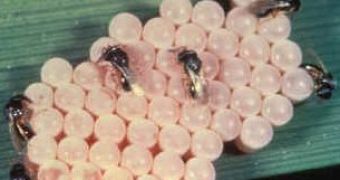When it's about sex, the main goal is reproduction. But when it's about calling for sex, the call can bring the end of the caller's kind.
Brazilian researchers found that parasitoid wasps spy on the "sex talk" of female stink bugs in order to detect new flash for their eggs.
The parasitoid wasps seem depicted from a science fiction movie: they lay their eggs inside insect adults, larvae or eggs and the hatching larvae consume from the inside their living host, trying to maintain it alive as much as possible.
Adult stink bugs keep most of their predators at a distance due to their foul-smelling secreted chemicals, but scelionid wasps love them, in fact, not the stinky adults, but their eggs, in which they lay their own eggs.
But finding new fresh eggs is not an easy task.
A team at Embrapa Recursos Gen?ticos e Biotecnologia led by Ra■l Laumann came with the following question: can wasps employ the conspicuous sex call of the bugs, transmitted through the plants by vibrating their bodies, to locate their eggs? The bugs' calls aim at informing on the individual's sex, location and sexual receptiveness, but this proved to be also valid for those wasps that find new host eggs. The team exposed parasitoid wasps to the sexual vibrations emitted by male and female Brazilian stink bugs. The wasps were located on either green bean plants or on an artificial substrate that allowed them an easy monitoring of the wasps' movements. No matter the substrate, wasps headed towards the source of the vibrations from female stink bugs, but not male stink bugs, and remained on the place that vibrated with the female songs. The wasps also displayed a behavior of searching around with their antennae as if they were looking for bug eggs.
"The wasps probably realize that eggs laid by female stink bugs could be close to the source of the vibrations. This study is the first to show that parasites tune into insects' vibratory sexual communication signals," said Laumann.

 14 DAY TRIAL //
14 DAY TRIAL //